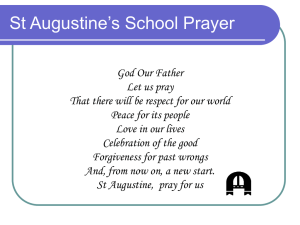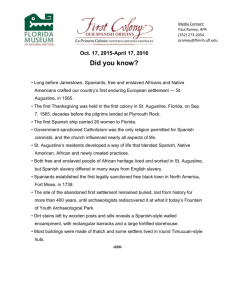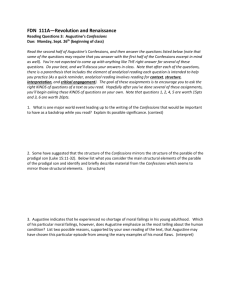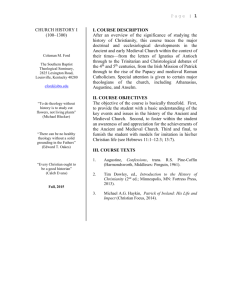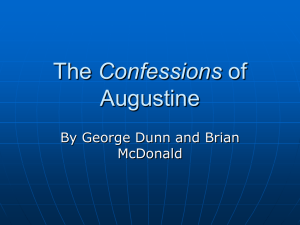Introduction to Augustine's Confessions
advertisement
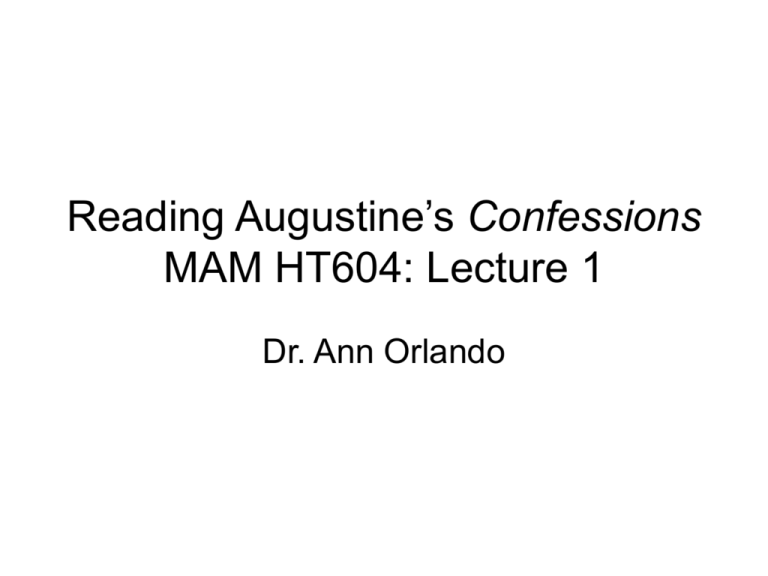
Reading Augustine’s Confessions MAM HT604: Lecture 1 Dr. Ann Orlando Outline • • • • • Why Read Augustine’s Confessions? Augustine’s Life and Works Introduction to Confessions How we will read Confessions Background on Books I - II Importance of Augustine • To Western Theology and Philosophy Augustine’s Importance Cannot Be Overstated • For Western Christianity, he is the most important theologian from this period – Arguably the most important theologian from any period • Every serious Western theologian after Augustine must in some way ‘deal’ with Augustine • Example: Far more references to Augustine in CCC ( Critical and Defining Issues for Augustine • • • • • • • Theodicy Epistemology Sacraments Theology of Trinity Ecclesiology Justification Primacy of love Examples • • Augustine was the standard for doctrinal truth and theological method throughout the Middle Ages Aquinas (13th C) runs into trouble because – – – • • • • Renaissance begins when Petrarch reads Confessions Luther and Calvin claim Augustine for themselves in opposition to Scholasticism Galileo tries to defend himself using Augustine (especially the Confessions) Early Modernity rejects Augustine’s definition of man as part of society – – • • • • Hobbes Locke Enlightenment rejection of Christianity is specifically a rejection of Augustine – – – • He seems to abandon Augustine’s theological method (Neoplatonism) for Aristotelianism But also because of primacy of intellect over will Open any page of ST and see number of references to Augustine Rousseau Voltaire Diderot Existentialists of 20th C continue campaign specifically against Augustine; Albert Camus The Plague Charles Freeman, The Closing of the Western Mind Recent new translations of and ‘popular’ interest in Augustine: New City Press; J.J. O’Donnell, Garry Wills Pope Benedict XVI has defined himself, and is often referred to as, an Augustinian theologian Why Read Confessions • Because… – Augustine is important – One of the most read books in Western literature – Presents many important points in theology • Really because Augustine the Bishop and fellow pilgrim toward the Kingdom of Heaven wants us to learn from his spiritual journey – Greatest theological reflection essay ever written – This is NOT a diary or an autobiography Introduction to Augustine • Man of late antiquity – Some (Copleston) see him as beginning of Middle Ages – Brown places him in late antiquity Historical Background • Late Antiquity and the Roman Empire – Political situation – Philosophical schools • Status of Catholic Church – Most potent heresy of 4th Century: Arianism – Books of the Bible Map of Roman Empire www.fsmitha.com/h1/map18rm.htm Social Situation Fourth Century • One of THE most important events in history happens in 4th Century: conversion of Roman Empire to Christianity • At the beginning of the Fourth Century, worst persecution of Christians (Emperor Diocletian) • Constantine the Great attributes his victory at the Milvian Bridge (312) in Rome to Christianity – After Constantine, large numbers of people become Christians • By the end of the century, Christianity declared official religion of Roman Empire by Theodosius the Great (381) Political and Military Situation • At beginning of 4th Century, Empire united under Diocletian and Constantine • Throughout 4th Century civil wars among Constantine’s sons and successors • Theodosius the Great reunites the Empire – Last Emperor of ‘entire’ Roman Empire • Barbarian invasions begin in West late 4th C, key moment is sack of Rome in 410 • Empire become divided East (capitol, Constantinople) and West (capitol, Rome) – Western Roman Empire ceases to exist 476 – Eastern Roman Empire ceased to exist 1453 Status of Catholic Church • In this period, no distinction between Catholic (West) and Orthodox (East) • Becomes ‘politically expedient’ to join Church • Most potent Christian heresy: Arianism – Belief that Christ was made by Father; not divine as Father is divine – Council of Nicea (325) called to combat Arianism; Creed – By end of 4th Century Arianism no longer a threat within Roman Empire • Another dangerous heresy: Donatism – – – – Prevalent in 4th Century North Africa Believed in strict Christian discipline Efficacy of sacraments depended on holiness of minister Augustine was main foe of Donatists Bible • Prior to 4th Century, many different views within Christianity about what is sacred scripture • Old Testament in or out? Some wanted to reject Old Testament completely – God seems angry, vengeful, anthropomorphic – Notion develops that creator god is evil and opposed to spiritual good god • Which books of New Testament? Some want to severely restrict books, some want to include other books • How to interpret the Bible, especially the Old Testament (more on this next week) – Literally – Allegorically Brief Biographical Sketch • Born near Carthage in 354 to a devoutly Catholic mother (St. Monica) and worldly father (Patrick) • In youth leads a life of pleasure searching for happiness – Flirts with Manichaeism – Becomes enamored with Platonism (Plotinus) • • • • Conversion to Catholic Christianity Ordained priest 391, bishop of Hippo 395 Died on 28 August 430 Peter Brown’s book Augustine of Hippo remains the most important biography of Augustine in English – Be sure to get the New Edition with Epilogue – Discusses discovery of 12 previously unstudied letters and sermons of Augustine (396-404) What did Augustine Look Like? • Augustine being baptized by Benozzo Gozzoli http://www.wff.org/StAugustine.html • Metropolitan Museum of Art http://www.metmuseum.org/toah/h o/05/afe/ho_18.9.2.htm Augustine’s Works • Augustine’s friend and biographer, Possidius, catalogued Augustine's works after his death and observed that no one would be able to read them all • Among the vitally important works – Against the Academics – On Free Will – Confessions – On the Trinity – City of God – On Christian Teaching – Retractions concerning On Free Will • Nearly innumerable letters, treatises, homilies, commentaries • Commentary, expositions, sermons on Psalms Introduction to Confessions • Written shortly after Augustine was named bishop of Hippo (395-400) • Written at the request of his friend Paulinus of Nola; 11 years after his baptism – It is Augustine the bishop reflecting in middle age on events in his youth; – It is not telling the story of his youth; it is a reflection • The 13 Books are Augustine's divisions – Confessions (as most books in antiquity) was serialized – Each of 13 Books was an installment • Became an instant best seller Confessions as Prayer • Confessio: both ‘accusation of oneself and praise for God’ Sermon 67.2 • It is first and foremost a prayer, not an autobiography; – The work is addressed to God • There should be an AMEN at end of Book XIII Which Translation Should You Read? • Henry Chadwick, Oxford University Press, 1991 • Mary Boulding, New City Press, 1997 • But please do not use translation available on the Web. It is very turgid, plotting Victorian English. Structure • Division of 13 Books is Augustine’s division • Usually considered in two parts: – Augustine’s past (I-IX) – Augustine's present (X-XIII) • NB: The last 4 books (Part 2) are an integral part of the whole • Later editors in 16th and 17th centuries added chapter and paragraph numbers Structure of Part 1 • Can be viewed as a chiasm • Book I: From God; birth and relationship of infant with mother – Book II: Bondage of Flesh • Book III: Slavery of eyes and mind; problem of evil – Book IV Ambition of World » Book V Encounter with Faustus, Manichaeism, philosophy; moving from Carthage to Rome – Book VI: Recognition of emptiness of world’s ambition • Book VII: Freedom of mind; resolution of problem of evil – Book VIII: Liberation from bondage of flesh • Book IX: Relation to Monica, her death, return to God Structure of Part 2 • Book X: Augustine the Bishop at the end of his reflection on his youth, meditates on – Memory and knowledge – Sin • Book XI: Augustine the Bishop meditates on – “In the beginning” – What is Time • Book XII: Augustine the Bishop meditates on – “God created the heavens and the earth” – How to interpret Scripture and authorial intent • Book XIII: Augustine the Bishop meditates on – Trinity – Church • NB: Augustine uses the word ‘confessions’ more often in these last four than the previous nine books Structure of Part 2 • Book X: Augustine the Bishop at the end of his reflection on his youth, meditates on – Memory and knowledge – Sin • Book XI: Augustine the Bishop meditates on – “In the beginning” – What is Time • Book XII: Augustine the Bishop meditates on – “God created the heavens and the earth” – How to interpret Scripture and authorial intent • Book XIII: Augustine the Bishop meditates on – Trinity – Church • NB: Augustine uses the word ‘confessions’ more often in these last four than the previous nine books • Confessio: both ‘accusation of oneself and praise for God’ Sermon 67.2 Our Plan for Reading Confessions • • • • • • • • • • Lecture 1: Introduction Lecture 2: Books I and II Lecture 3: Books III and IV Lecture 4: Books V and VI Lecture 5: Books VII and VIII Lecture 6: Book IX Lecture 7: Book X Lecture 8: Book XI and XII Lecture 9: Book XIII Week 10: Conclusions Three Part Hermeneutic Approach • Historical and philosophical background on each Book – Historical and social context – Intellectual movements – People • Key aspects of the Book itself – Truth about human nature • • • • Epistemology Language Evil and sin Love and Happiness – Truth about Creation – Truth about God – Connections between Book understudy and other Books • Influence of Confessions – Impact in later intellectual history – How does this theological reflection touch us Another Perspective: What Is Augustine Reading • • • • • • • • • • • • Book I: School books on Greek grammar, Virgil Aeneid Book II: Sallust, Catiline Book III: Cicero, Hortensius, and Old Testament Book IV: Manichean texts, Aristotle Book V: Compares Manichean texts with astronomy; reads Academics; Ambrose explains Old Testament Book VI: Ambrose continues to explain Old Testament; Book VII: Platonists and Paul Book VIII: Athanasius, Life of Antony and Paul Book IX: Isaiah Book X: Reading himself (memory) Book XI, XII, XIII: Interpreting Genesis But all now understood through Scripture, as a theological reflection Augustine's On Christian Teaching • Written about the same time he wrote the Confessions • Purpose is to describe how to interpret Scripture to arrive at truth then to preach it • Prolog: Addressed to opponents • Book I: Advancing in love of God and neighbor is acid test for understanding Scripture: – So anyone who thinks he has understood the divine scriptures or any part of them, but cannot by his understanding buildup this double love of God and neighbor, has not yet succeeded in understanding them. (I.xxvi.40.86) • Book II: Reading Scripture, Language, Spiritual Progress • Book III: Detailed Rules for analyzing Scripture • Book IV: How to Preach Assignment • Read On Christian Teaching Prolog and Book I – Skim Book II • Start one discussion thread • Respond to two threads Two Web Resources • Three Volume Commentary (Latin text, English descriptions) on Confessions by JJ O’Donnell, http://www.stoa.org/hippo/ • Online Cliff Notes, http://www.cliffsnotes.com/WileyCDA/LitNote/StAugustine-s-Confessions.id-166,pageNum-1.html
